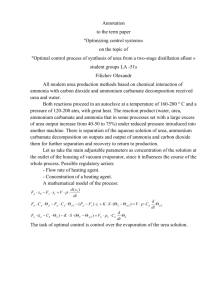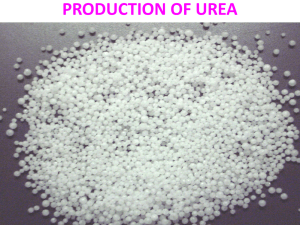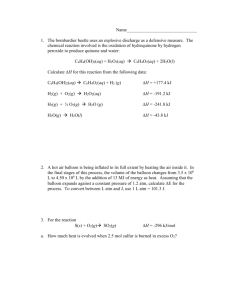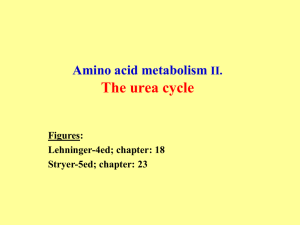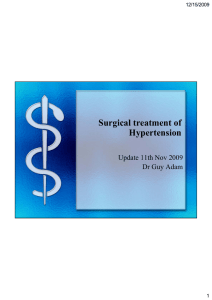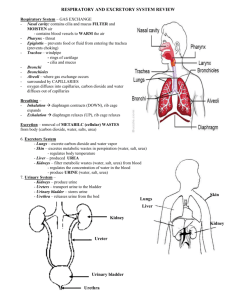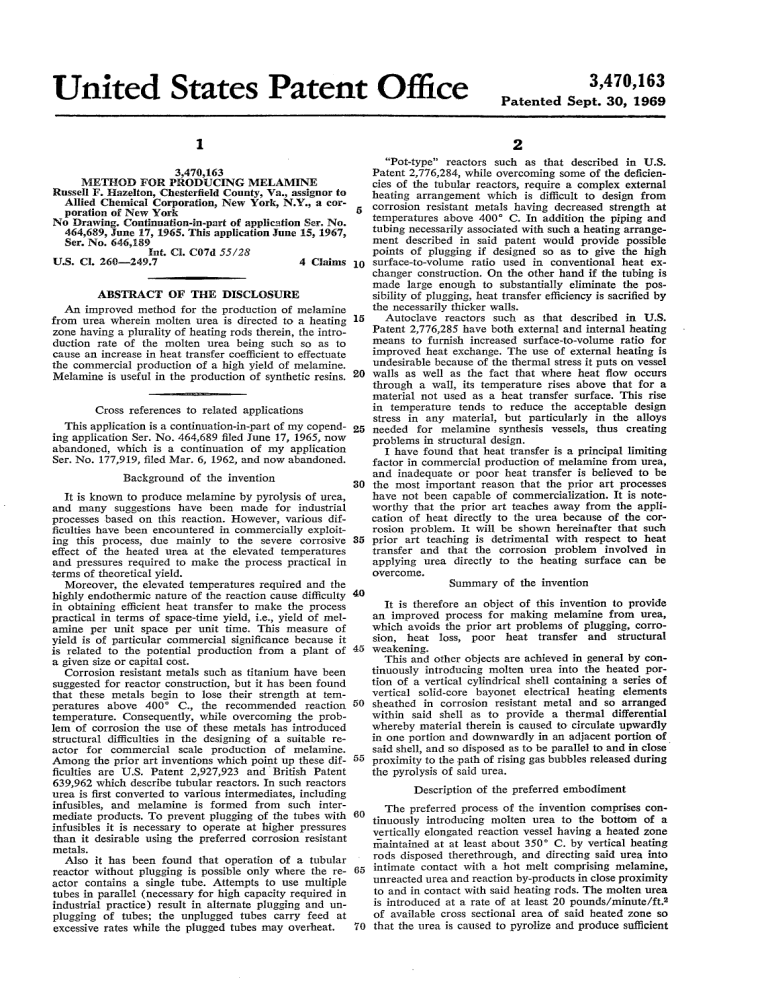
United States Patent Office Patented Sept. 30, 1969 2 "Pot-type' reactors such as that described in U.S. 3,470,163 METHOD FOR PRODUCING MELAMINE Russeli F. Hazelton, Chesterfield County, Va., assignor to Allied Chemical Corporation, New York, N.Y., a cor poration of New York No Drawing. Continuation-in-part of application Ser. No. 464,689, June 17, 1965. This application June 15, 1967, 5 Ser. No. 646,189 nt. C. C07 55/28 U.S. C. 260-249.7 4 Claims O ABSTRACT OF THE DISCLOSURE An improved method for the production of melamine from urea wherein molten urea is directed to a heating Zone having a plurality of heating rods therein, the intro duction rate of the molten urea being such so as to cause an increase in heat transfer coefficient to effectuate the commercial production of a high yield of melamine. Melamine is useful in the production of synthetic resins. the necessarily thicker walls. 5 undesirable because of the thermal stress it puts on vessel 20 walls as well as the fact that where heat flow occurs 25 Background of the invention It is known to produce melamine by pyrolysis of urea, 30 Ser. No. 177,919, filed Mar. 6, 1962, and now abandoned. and many suggestions have been made for industrial processes based on this reaction. However, various dif practical in terms of space-time yield, i.e., yield of mel amine per unit space per unit time. This measure of yield is of particular commercial significance because it is related to the potential production from a plant of a given size or capital cost. 35 OWeCOc. 40 45 50 lem of corrosion the use of these metals has introduced structural difficulties in the designing of a suitable re actor for commercial scale production of melamine. Among the prior art inventions which point up these dif ficulties are U.S. Patent 2,927,923 and British Patent 639,962 which describe tubular reactors. In such reactors urea is first converted to various intermediates, including infusibles, and melamine is formed from such inter mediate products. To prevent plugging of the tubes with infusibles it is necessary to operate at higher pressures than it desirable using the preferred corrosion resistant metals. through a wall, its temperature rises above that for a material not used as a heat transfer surface. This rise in temperature tends to reduce the acceptable design stress in any material, but particularly in the alloys needed for melamine synthesis vessels, thus creating problems in structural design. I have found that heat transfer is a principal limiting factor in commercial production of melamine from urea, and inadequate or poor heat transfer is believed to be the most important reason that the prior art processes have not been capable of commercialization. It is note worthy that the prior art teaches away from the appli cation of heat directly to the urea because of the cor rosion problem. It will be shown hereinafter that such prior art teaching is detrimental with respect to heat transfer and that the corrosion problem involved in applying urea directly to the heating surface can be Corrosion resistant metals such as titanium have been suggested for reactor construction, but it has been found that these metals begin to lose their strength at tem peratures above 400 C., the recommended reaction temperature. Consequently, while overcoming the prob Autoclave reactors such as that described in U.S. Patent 2,776,285 have both external and internal heating means to furnish increased surface-to-volume ratio for improved heat exchange. The use of external heating is Cross references to related applications This application is a continuation-in-part of my copend ing application Ser. No. 464,689 filed June 17, 1965, now abandoned, which is a continuation of my application ficulties have been encountered in commercially exploit ing this process, due mainly to the severe corrosive effect of the heated urea at the elevated temperatures and pressures required to make the process practical in terms of theoretical yield. Moreover, the elevated temperatures required and the highly endothermic nature of the reaction cause difficulty in obtaining efficient heat transfer to make the process Patent 2,776,284, while overcoming some of the deficien cies of the tubular reactors, require a complex external heating arrangement which is difficult to design from corrosion resistant metals having decreased strength at temperatures above 400° C. In addition the piping and tubing necessarily associated with such a heating arrange ment described in said patent would provide possible points of plugging if designed so as to give the high Surface-to-volume ratio used in conventional heat ex changer construction. On the other hand if the tubing is made large enough to substantially eliminate the pos sibility of plugging, heat transfer efficiency is sacrified by 55 60 Summary of the invention It is therefore an object of this invention to provide an improved process for making melamine from urea, which avoids the prior art problems of plugging, corro sion, heat loss, poor heat transfer and structural weakening. This and other objects are achieved in general by con tinuously introducing molten urea into the heated por tion of a vertical cylindrical shell containing a series of vertical solid-core bayonet electrical heating elements sheathed in corrosion resistant metal and so arranged within said shell as to provide a thermal differential whereby material therein is caused to circulate upwardly in one portion and downwardly in an adjacent portion of said shell, and so disposed as to be parallel to and in close proximity to the path of rising gas bubbles released during the pyrolysis of said urea. Description of the preferred embodiment The preferred process of the invention comprises con tinuously introducing molten urea to the bottom of a vertically elongated reaction vessel having a heated zone maintained at at least about 350° C. by vertical heating rods disposed therethrough, and directing said urea into intimate contact with a hot melt comprising melamine, unreacted urea and reaction by-products in close proximity to and in contact with said heating rods. The molten urea Also it has been found that operation of a tubular reactor without plugging is possible only where the re 65 actor contains a single tube. Attempts to use multiple tubes in parallel (necessary for high capacity required in is introduced at a rate of at least 20 pounds/minute/ft. industrial practice) result in alternate plugging and un of available cross sectional area of said heated zone so plugging of tubes; the unplugged tubes carry feed at excessive rates while the plugged tubes may overheat. 70 that the urea is caused to pyrolize and produce sufficient 3 3,470,163 gases in close proximity to said heating rods to cause a violent agitation of said melt in the area thereof to facili tate a cleansing of the rods of heated melt to result in an increased heat transfer for increasing the Space-time yield of the melamine. Moreover, the gases cause the melt to circulate upward through said heated Zone, and substan tially throughout its circulation therethrough heat is added to the melt so as to continuously pyrolize the urea to melamine. The gaseous by-products and part of the mel amine are removed from the upper portion of the reaction vessel, and the remaining part, consisting of a substantially gaseous free, relatively denser material, is recirculated to the lower portion of said reaction vessel with the aid of downward thermal flow into a relatively cooler Zone remote from said heating rods. The recirculated part of melamine from said cooler zone is introduced into said 4. Urea feed rate, pounds/minute/ sq. ft. cross section of heated 5 10 5 heated zone, and the pressure on said circulating melt is maintained at at least 2000 p.s.i.g. The molten urea is injected into the reaction mixture at a rate of at least about 20 pounds/minute/ft. of avail 20 able cross sectional area of the heated zone and against the heating surface to obtain a heat transfer coefficient of at least about 240 B.t.u./hr./ft. of heating surface/ F. difference between the temperature of the heating surface and the temperature of the reaction mixture. Desirably, 25 the molten urea is injected at a rate of about 35-70 pounds/minute/ft. of available cross sectional area of the heated zone, or at even higher rates, to obtain greater space-time yields of melamine. It might be expected that operation of the proposed 30 process at the indicated higher urea input rates would adversely affect the conversion of the urea to melamine. Surprisingly, however, the heat transfer coefficient in creases in almost straight line relationship with increasing urea feed rate so that ample heat is furnished and the 35 product contains at least 90 weight percent melamine. Un expectedly, such heat transfer has now been discovered to be essential for the commercial production of melamine from urea. A further understanding of the nature and objects of 40 the invention will be had from the following description and examples. Example I Example I shows that heat transfer coefficient increases in almost straight line relationship with increasing urea feed rate expressed in terms of pounds of urea injected per minute per square foot of cross section of the heated portion of the reaction mixture. The reactor used in this example was similar to that disclosed in my U.S. Patent 3,271,116 constructed of 50 Hastelloy C, which is known to be highly resistant to cor rosion. The reactor used was three inches in interior diam eter and thirty-five inches in internal height. Normal liq uid depth was thirty-one inches. Draft tube was two inches in diameter and twenty-nine inches in length with %-inch legs at the base. A tube four inches in length ex tended downward from the top of the reactor for product withdrawal. The heating bayonet, located inside the draft tube, was 0.8 inch in diameter and extended about twenty eight inches into the reactor. Urea was fed at the base of the bayonet, inside the draft tube. At start of the test, the reactor was still hot (about 400 C.) from a preceding run but was empty. Urea flow 55 60 was started at a slow rate which would fill the reactor in about 200 minutes. Reactor and contents were maintained at about 400° C. during filling of the reactor. Pressure was was being prepared at a slow rate and circulation in the adjusted to 2,000 p.s.i.g. After 215 minutes, melamine effect of urea feed rate. zone of reactor: 6.2 ------------------------------------8.3 ------------------------------------12.5 -----------------------------------15.8 -----------------------------------21.6 ------------------------------------ 132 145 180 215 248 It will be seen from the above data that heat transfer coefficient increased in almost straight line relationship with increasing area feed rate. This is attributed to the agitation of the reaction mixture adjacent to the heater by gases given off from the reacting urea. Example II Molten urea is pumped to the reactor about /2 rate or about 4 gallons per minute for a 22-inch diameter, 16-foot reactor having a draft tube of about 8/8 inches interior diameter and 105 bayonet-type heating rods of about 34 inch outside diameter in the annulus, the available cross sectional area of the annulus being about 2 ft. During start-up, the reactor heaters are set for 380° C. maximum. As soon as the liquid reaches the top of the draft tube, circulation begins. When the level indicator indicates that the liquid level is above the heaters, the temperature con troller is reset for 400° C. Filling requires 3 to 4 hours' ?time. As soon as the product stream emerges through the discharge line, the urea feed to the reactor is increased to the desired rate. The following tabulations show the compositions of the inlet and exit streams: INLET FEED Component Weight percent Mols/hour Impurities---------------H2O---------------------Total.--------------- 97.1 Trace 0.5 2.1 0.3 100.0 137.85 0.01 0.30 i.75 150 14.41 Pounds/hour 18,271 38 180 27 8,517 1 Equivalent to about 70 lbs./min. Ift.2 of available cross-section on the annular portion of the reactor. REACTOR EXIT Component Melamine----------------Armineline-ammelide.----Impurities---------------NH3---------CO2---------Total.------------- Weight percent Mols/hour 32.7 2.5 0.7 28.0 36.1 100.0 22,07 1,68 0.61 141.63 69.84 235.83 Pounds/hour 2,781 214 63 2,408 3,073 8,539 As molten urea is heated above 350° C., it passes through various infusible intermediate stages in its con version to melamine. It is established that these interme diates are responsible for the plugging and corrosion which caused so much difficulty in the prior art. Plugging and ex cessive corrosion are avoided in the present invention in the following manner: As molten urea is fed into the reactor, the reactant is distributed in liquid melamine (which is relatively non corrosive) in the annulus between the draft tube and the wall of the reactor. The annular space contains the elec trical heating elements which supply the heat required for rapid pyrolysis of urea to melamine. The urea is dis persed evenly into the mass of circulating liquid melamine and is converted into melamine on absorption of heat. This method of operation avoids high local concentrations of insoluble or corrosive intermediates. As stated abwe, the molten urea is directed to the bot reactor was well established. After reactor start-up, the urea feed rate was varied over a wide range to show effect on heat transfer. All tests were made at about 2,000 p.S.i.g. reactor pressure. Product was satisfactory in all tests and contained at least 90 weight percent melamine. The following table shows Heat transfer co efficient, B.t.u./hr./sq. ft. of heating surface/ F. 70 75 ton of the heated Zone and into close proximity to and in contact with the heating Surfaces to obtain maximum heat transfer with corresponding high space-time yields of melamine. It is important to direct the urea into contact with the heating surfaces to cleanse he surface of heated material, i.e., the gases given off by the reacting urea tend 5 3,470,163 to scrub or wipe the heating surface clean of heated ma terial so that this heated material may be quickly and con tinuously replaced with relatively cooler material. With to said melt so as to continuously pyrolize the urea increased urea feed up to 70 pounds/minute/ft. of avail to melamine, able cross sectional area of the heated Zone, the heat transfer is increased without detrimental effect on the yield of melamine as a percent of theoretical yield. More over, the space-time yield is greatly increased as com pared with prior art processes in which urea is fed into molten melamine and out of contact with heating surfaces. It is to be understood that changes in the aforede scribed method steps may be made without departing from the spirit of our invention; and that all exemplifications and variants of my novel method, set forth hereinabove, are intended to be illustrative only, and in no sense limita tive of the invention other than as the same is defined in the accompanying claims. I claim: 1. A process for the production of melamine from urea which comprises: continuously introducing molten urea to the bottom of a vertically elongated reaction vessel having a heated Zone maintained at at least about 350° C. by vertical heating rods disposed therethrough, directing said urea into intimate contact with a hot melt comprising melamine, unreacted urea and reac tion by-products in close proximity to and in con tact with said heating rods, maintaining the introduction of Said molten urea at a rate of at least 20 pounds per minute per square foot of available cross section of said heated Zone, there by causing said urea to pyrolize and produce gases which rise in close proximity to said heating rods resulting in a violent agitation of said melt in the area thereof to facilitate a cleansing of the rods of heated melt to produce a maximum heat transfer for rela tively increasing the space time yield of the melamine, said gases further causing the melt to circulate up 6 ward through said heated zone, and substantially throughout its circulation therethrough adding heat O 15 removing part of the melamine and gaseous by-products from the upper portion of said reaction vessel, recirculating the remaining part, consisting of a substan tially gaseous free, relatively denser material than said part removed, to the lower portion of said reac tion vessel by downward flow into a relatively cooler zone remote from said heating rods, introducing the recirculated part from said cooler Zone directly into the heated zone, and maintaining pres sure on said circulating melt of at least 2000 p.s.i.g. 2. The process of claim 1 wherein the rate of introduc ing said molten urea preferably ranges from about 35-70 pounds per minute per square foot of available cross sec tion of said heated zone. 20 25 3. The process of claim 2 wherein the urea is directed against the heating surface of the rods so as to obtain a heat transfer coefficient of at least about 240 B.t.u. per hour per square foot of heating surface per degree Fahren heit difference between the temperature of the heating surface and the temperature of the reaction mixture. 4. The process of claim 3 wherein a relatively increased introduction rate of urea causes a relatively increased heat transfer coefficient thereby resulting in the production of a product containing at least 90 weight percent melamine. References Cited UNITED STATES PATENTS 30 35 2,776,284 2,776,285 3,271,116 1/1957 Hood ------------- 260-249.7 1/1957 Dyer ------------- 260-249.7 9/1966 Hazelton ---------- 260-249.7 HENRY R. JILES, Primary Examiner JOHN M. FORD, Assistant Examiner
